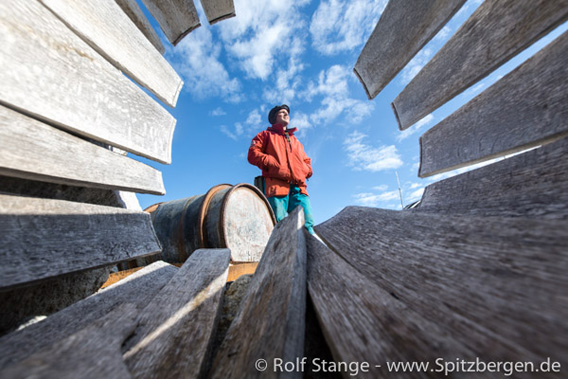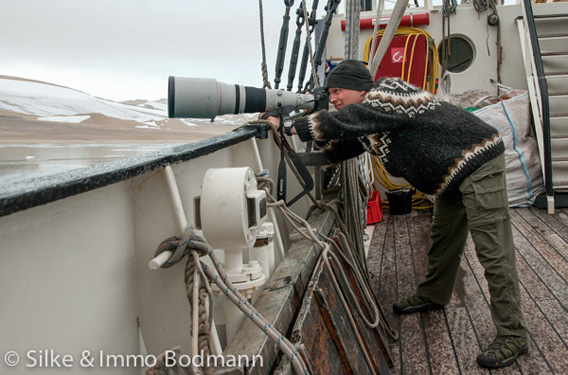Seitenstruktur
-
Spitsbergen-News
- Select Month
- March 2020
- February 2020
- March 2019
- January 2019
- December 2018
- September 2018
- June 2018
- May 2018
- April 2018
- March 2018
- February 2018
- January 2018
- December 2017
- November 2017
- October 2017
- September 2017
- June 2017
- May 2017
- April 2017
- March 2017
- February 2017
- January 2017
- December 2016
- September 2015
- April 2015
- March 2015
- February 2015
- January 2015
- December 2014
- October 2014
- August 2014
- June 2014
- May 2014
- April 2014
- March 2014
- November 2009
- April 2000
- Select Month

| Grytviken |
Home
→ Polar photography
Polar photography
Equipment and tips

Photography is becoming increasingly more important to me and many others, and questions about it, about how I am working, are getting more frequent. I’ll answer some of them here. I may add stuff as questions come up.
You can get nice pix with any little camera. But to get high-quality images, you need some serious equipment. In other words: professional equipment is expensive and heavy. Unfortunately, there is no way around this, if you want to get everything out of unique opportunities, quality-wise. You’ll see what I mean especially in difficult situations, for example low-light, when photos taken with small aperture lenses and small sensor cameras will turn out to be of inferiour quality. Or with animals that are far away. You can’t just blow up a wildlife photo with a 2-pixel-polar bear on the computer and expect it to be great. At least when you look at it more closely. If you don’t care too much about it – the better for you, it will keep your life a lot simpler.
I take a lot of photographs many months every year on a daily basis and I am using the results professionally. That should be kept in mind when reading my equipment list, especially when you look the prices up. A frequent question is: do I really need a lot of expensive stuff for a trip to the Arctic or Antarctic? The simple and true answer is: no. You can get beautiful stuff with much less equipment. It’s only if you care about the very last bits of quality that you can get out of all kinds of situations, to get 110 % quality, then you need professional equipment. Most people will be perfectly happy with 95 % of that quality, and that’s something you’ll get with most smaller up-to-date cameras. If you want to gear up for a trip to Antarctica or Spitsbergen, but you haven’t really had much interest in photography so far, then something like the Canon 700D or the 70D (or equivalent bodies of any other company) ill be good choices. If you want to enter on a higher level and you have, say, wildlife as a main interest, then consider the Canon 7D (dito). Advanced readers know what they want.
Here is my own commented equipment list. And no, I am not sponsored or paid by Canon or anyone else for this, I pay for my stuff just as anyone else. Of course I pack my bag for the situation to come, it is impossible to carry everything in the field.
Cameras
- Canon 5D Mark III. My main workhorse and something I recommend to anyone looking for a professional body, unless you are already settled on another supplier with your lenses etc. Full-frame sensor, fast, robust, HD-video-function.
- Canon Mark IV. Very fast, with a slightly smaller sensor, optically increasing the focal length of lenses, which is advantageous for wildlife photography. But you won’t be able to make full use of your wide-angles with a crop-factor-sensor. Bigger and heavier than the 5D Mark III, so I use the Mark IV mainly for wildlife photography from ships.
- Canon 5D Mark II. The predecessor of the Mark III. Full-frame sensor with good image quality, but comparatively slow autofocus. That’s why I decided to upgrade and get the Mark III. But still an excellent backup and I use it happily whenever speed does not matter.

Even the best and most robust camera body won’t like it when you treat it badly. An overthrown tripod cost me almost 1000 Euro in a second here. Insurance cover for your expensive equipment is definitely a good idea.
Lenses
I am doing a lot of my photography while travelling with groups on ships and while hiking on shore. So situations are always changing quickly, and I need to be able to adjust at any time. As a result, I use mostly zoom-lenses to be flexible in my everyday work. Whenever possible, however, I like to use prime lenses with fixed focal length because of their better optical quality and light strength. But they are heavier, more expensive and less flexible.
And, by the way, I have realized that it is too expensive to buy cheap lenses. Get good stuff rightaway rather than buying something cheap today and something more expensive later. Two good lenses will serve you better than three cheap ones.
Zoom lenses
- Canon EF 24-105 mm f/4,0 L IS USM. This lense covers many situations in everyday use. If I could take only one lense with me, it would usually be this one.
- Canon EF 16-35 mm f/2.8 L II USM. I love wide-angle photography, so this is a lense that I am using a lot.
- Canon EF 100-400 mm f/4.5-5.6 L IS USM. My tele-zoom that I have almost always with me, also during hikes.
- Canon EF 8-15 mm f/4 L USM (Fisheye zoom). Special lense that most normal people won’t need. Only used for special artistic effects and for panorama photography. It’s the latter that I am using it for, and quite a lot. Not much else.

At work with the wide-angle lense
Additionally, I have the following prime lenses with fixed focal length:
- Canon EF 24 mm f/1.4 L II USM. Very big aperture and my secret weapon for the Aurora borealis (northern light). And in any other low-light situation.
- Canon EF 50 mm f/1.2 L USM. High-quality standard focal length. I don’t use it too much, although the optical qualities are exciting. I just find the perspective a bit boring. Well, I am probably just not able to use it properly. Great lense for portrait photography. But polar bears rarely come that close, that’s the problem.
- Canon EF 100 mm f/2.8 L Macro IS USM. Short tele, mainly used as macro, for example for flowers. Very enjoyable. Excellent quality, so I also use it for landscape whenever I can.
- Canon EF 600 mm 1:4 L IS II USM. Others buy a motorbike when they are passing 40, I bought this lense. A great thing! Of course an extreme focal length that can only be used in certain situations: obviously wildlife that is far away and that doesn’t move too quickly. Forget about photographing an Arctic tern with it that is changing flight direction and speed by the second, but impossible to beat when that polar bear just doesn’t want to come any closer with his seal meal. Amazing optical quality. But too big and heavy to carry around during hikes, so I use it almost exclusively from the ship. A smaller tele lense will make most people perfectly happy (and still leave you with enough cash to go for a trip …).

At work with the 600 mm lense. It does almost not matter anymore how far the animals are away. Well, almost.
And what else:
- Canon Extender EF 1.4x III, a tele converter. When the polar bear is still too far away for the 600 mm lense.
- Flashlight. Never far away, although I don’t use it too much. I prefer available light as much as possible. But inside, when there is no time or space for a tripod, it can be very useful, or outside with very bright back light.
- Tripod. An important thing that is never far away and I use it as often as I can.
- Panorama head. In my luggage since early 2013 and now frequently used for my growing collection of polar panoramas. You can take a hand-held panorama of the scenery in the distance, but forget about it when things are closer, then you need proper panorama equipment.
- Filters. I don’t use them too much, mainly the simply ones to protect the front lense. But it is important to get high quality filters. Why ruin the benefit of a high-quality lense with a cheap filter.
- Don’t forget regular clean-and-check of your equipment. Don’t come with half a kilo of desert sand on the sensor to Antarctica and expect quality images ☺
A 24 mm tilt-and-shift would be the next thing to buy for me if I could afford it, to photograph settlements and huts without optical distortion. So if you want to sponsor me, that would be an option ☺ but in the meantime, if you buy some of my books or a calendar, you’ll also help me to get there.

A completely different toy …
last modification: 2023-12-18 ·
copyright: Rolf Stange

























